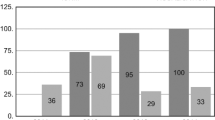Summary
BACKGROUND: Employment of intraoperative neuromonitoring (IONM) of the recurrent laryngeal nerve (RLN) is not unusual nowadays. But up to now, no prospective beneficial studies have been available that evaluate whether the additional use of IONM is beneficial and safe in comparison with conventional thyroid surgery. METHODS: Between 1 August 1999 and 31 January 2001, surgery for benign and malignant goitre was performed on 8900 patients with 16148 nerves at risk. Twenty-eight German hospitals participated. Data were collected prospectively by a questionnaire. Employment of IONM depended on the performing surgeon and was not randomized or controlled. RESULTS: IONM was used in 95.9% (range 57.2–100%) of all thyroid operations. The use of IONM significantly decreased the early RLN palsy rate (3.3% vs. 4.9%; P = 0.04). As for the permanent RLN palsy rate, there was still an advantage gained by using IONM (0.7% vs. 0.9%); however, this difference lacked statistical significance. Overall, IONM was beneficial in high-risk procedures such as recurrent goitre, thyroid carcinoma and extended resections. Employment of the translaryngeal needle electrode of IONM has no influence on general morbidity such as haematomas or wound infections. CONCLUSIONS: The technique of IONM of the RLN in thyroid surgery is safe and decreases the overall RLN palsy rate. IONM in thyroid surgery is especially recommended in high-risk procedures such as recurrent goitre, thyroid carcinoma and extended resections.
Zusammenfassung
GRUNDLAGEN: Seit einigen Jahren wird das intraoperative Neuromonitoring (IONM) des N. laryngeus recurrens in der Schilddrüsenchirurgie eingesetzt. Aktuell sind jedoch keine prospektiven Studien vorhanden, welche beweisen, daß das intraoperative Neuromonitoring im Vergleich zur konventionellen Rekurrensdarstellung eine niedrigere postoperative Pareserate ermöglicht. METHODIK: Zwischen August 1999 und Januar 2001 wurden 8900 Patienten mit 16148 „nerves at risk“ wegen einer malignen oder benignen Struma operiert. Die Daten wurden mit Hilfe eines Erfassungsbogen prospektiv von 28 deutschen Krankenhäusern erhoben. Der Einsatz des IONM wurde vom Chirurgen bestimmt und nicht durch das Studienprotokoll randomisiert. ERGEBNISSE: In den verschiedenen Krankenhäusern wurde das IONM in 95,9% (Spannweite 57,2–100%) aller Schilddrüsenoperationen eingesetzt. Der Einsatz des IONM senkte signifikant die Rate an frühpostoperativen Rekurrensparesen (3,3% vs. 4,9%, P = 0,04). Bei der permanenten Rekurrensparese zeigte sich zwar ebenfalls ein Vorteil für das IONM (0,7% vs. 0,9%), dieser Unterschied war aber nicht signifikant. Insgesamt zeigte sich, daß der Einsatz des IONM bei den Risikoeingriffen Rezidivstruma, Schilddrüsenkarzinom und ausgedehnte Resektionen vorteilhaft war. Der Einsatz der translaryngealen Ableitelektrode des IONM hatte keinen Einfluß auf die Inzidenz von Hämatomen oder Wundinfektionen. SCHLUSSFOLGERUNGEN: Die Technik des IONM des N. laryngeus recurrens ist sicher und senkt die Rate der postoperativen Pareserate. Insbesondere für Risikoeingriffe wie die Rezidivstruma, das Schilddrüsenkarzinom und für ausgedehnte Resektionen ist das IONM besonders empfehlenswert.
Similar content being viewed by others
Author information
Authors and Affiliations
Corresponding author
Rights and permissions
About this article
Cite this article
Thomusch, O., Sekulla, C., Timmermann, W. et al. Intraoperative Neuromonitoring in Thyroid Surgery. Eur Surg 35, 240–245 (2003). https://doi.org/10.1007/s10353-003-0019-6
Issue Date:
DOI: https://doi.org/10.1007/s10353-003-0019-6




